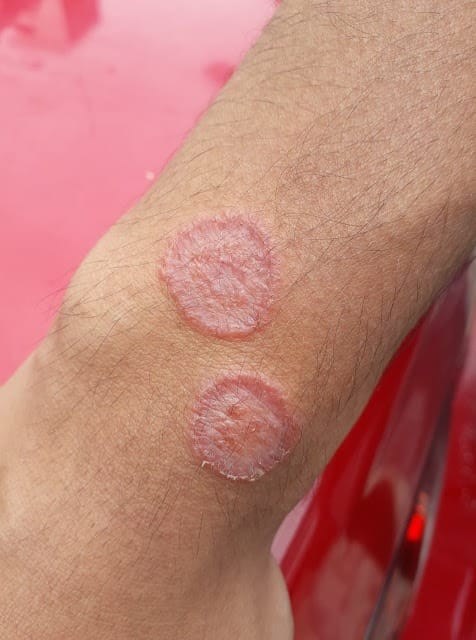
Ringworm of the Body: Causes, Symptoms, Treatment, and Prevention
What is Ringworm of the Body?
Ringworm of the body, also known as tinea corporis, is a common fungal infection that causes circular or ring-shaped rashes on the skin. Despite its name, it isn’t caused by a worm, but rather by fungi called dermatophytes. These fungi thrive on keratin, a protein found in skin, hair, and nails, leading to skin irritation and the characteristic ring-shaped rash. Though it’s highly contagious, ringworm is typically mild and can be effectively treated.
Causes of Ringworm
Ringworm is caused by dermatophytes, a group of fungi that prefer warm, moist environments. The infection spreads in a few main ways:
- Direct contact with an infected person’s skin.
- Indirect contact through shared items like towels, clothing, or sports gear.
- Infected animals, especially cats and dogs, can pass on the infection to humans.
- Warm, humid environments such as gyms, swimming pools, and locker rooms are ideal for the fungi to grow and spread.
Risk Factors for Ringworm
While anyone can develop ringworm, certain factors can increase your risk:
- Living in hot, humid climates where fungal growth is more common.
- Wearing tight, moisture-wicking clothing that traps sweat and fosters fungal growth.
- Frequent contact with animals, especially pets showing signs of skin infections.
- Sharing personal items like towels, shoes, or combs with someone who has ringworm.
- Having a weakened immune system, such as those with diabetes or HIV/AIDS.
Symptoms of Ringworm
Symptoms of ringworm typically show up 4 to 10 days after exposure to the fungus. The most recognizable sign is a circular, red rash with raised edges, often with a clear center, giving it a “ring” appearance. Common symptoms include:
- Circular or ring-shaped rashes with red, raised borders.
- Intense itching in the affected area.
- Scaly or cracked skin around the rash.
- Burning or mild irritation.
In more severe cases, the infection may spread, causing:
- Expanding rings or merging patches.
- Pus-filled blisters or sores.
- Redness or swelling.
- Hair loss if the infection affects hairy areas like the scalp.
Common Areas for Ringworm
Ringworm can appear anywhere on the body but most commonly affects the:
- Arms and legs
- Chest and back
- Face and neck
It usually avoids the palms of the hands, soles of the feet, groin area, and scalp, as other types of fungal infections typically occur in these regions.
How is Ringworm Diagnosed?
A healthcare provider, usually a dermatologist, will diagnose ringworm based on the appearance of the rash. Diagnosis methods include:
- Visual exam: A doctor examines the rash’s distinct ring-shaped pattern.
- Skin scraping: A small sample of skin may be taken to check for fungal cells under a microscope.
- Fungal culture: Sometimes, the sample is sent to a lab to identify the specific type of fungus.
Proper diagnosis is crucial to differentiate ringworm from other skin conditions, such as eczema or psoriasis.
Treatment for Ringworm of the Body
Most cases of ringworm can be treated with antifungal medications, depending on the infection’s severity.
- Topical Treatments: For mild to moderate infections, antifungal creams, gels, or ointments can be applied directly to the rash. Common ingredients include:
- Clotrimazole
- Miconazole
- Terbinafine
- Ketoconazole
These treatments are typically applied 2 to 3 times a day for 2 to 4 weeks. - Oral Medications: For more severe infections or those resistant to topical treatments, oral antifungals may be prescribed. Options include:
- Griseofulvin
- Itraconazole
- Oral terbinafine
Oral antifungals are typically taken for 4 to 6 weeks and may require monitoring for side effects.
Preventing Ringworm
Ringworm is highly contagious, so preventing its spread is essential. Here are a few preventive measures:
- Maintain good hygiene by washing and thoroughly drying your skin, especially after showers or swimming.
- Avoid sharing personal items like towels, clothing, combs, or shoes.
- Wear loose, breathable clothing to reduce moisture buildup and fungal growth.
- Wash bedding and towels regularly in hot water, particularly if someone in your home has ringworm.
- Disinfect common areas like bathrooms, gyms, and locker rooms, especially after public use.
- Care for pets: If your pet shows signs of skin lesions or hair loss, take them to the vet to avoid transmission.
When to See a Doctor
Consult a healthcare provider if:
- Symptoms worsen or don’t improve after 2 weeks of treatment.
- The rash rapidly spreads or affects sensitive areas like the face.
- Painful blisters or pus-filled sores develop.
- You experience secondary symptoms, such as fever or severe inflammation.
Conclusion
Ringworm of the body is a treatable and common infection that, though uncomfortable, usually resolves with proper care. With antifungal treatments, most people recover fully. Taking steps to prevent the infection, like practicing good hygiene, avoiding shared items, and caring for pets, can help reduce the spread of ringworm and keep you and others healthy.


